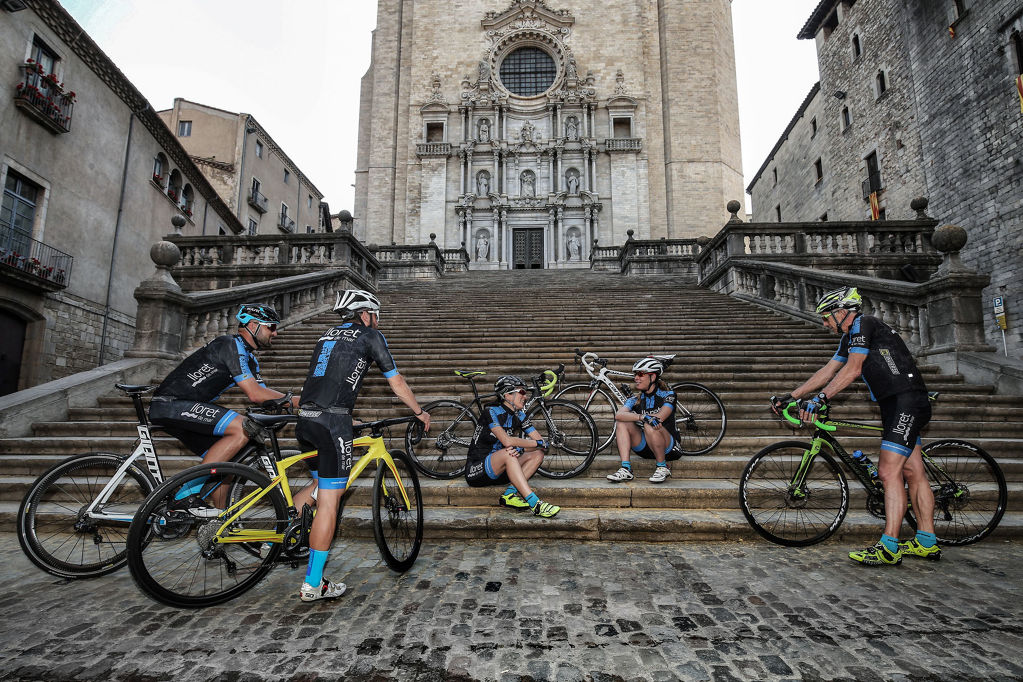
Lloret de Mar - Sant Grau - Els Àngels - Girona - Lloret de Mar
Lloret de Mar - Sant Grau - Els Àngels - Girona - Lloret de Mar
 Distance:
134 km
Distance:
134 km
 Elevation gain:
1.850 m
Elevation gain:
1.850 m
 Max. Elevation:
450 m
Max. Elevation:
450 m
Water points
- Tossa de Mar
- Sant Grau
- Cassà de la Selva
- Madremanya
- Girona
- Quart
- Llagostera
- Tossa de Mar

|
MOUNTAIN PASSES |
CATEGORY |
DISTANCE |
ELEV. CHANGE |
AVERAGE % |
MAX. GRADE |
||
|
Alt de Sant Grau |
2 |
7 km |
5,59 mi |
400 m |
1.138 ft |
5,6% |
14% |
|
Coll de Santa Pellaia |
3 |
6 km |
3,72 mi |
200 m |
1.342 ft |
3,5% |
10% |
|
Alt dels Àngels |
2 |
6 km |
3,72 mi |
310 m |
1.017 ft |
5,6% |
10% |
|
SECTIONS WITH TRAFFIC DENSITY / ROAD SURFACE DEFECTS |
HIGH DENSITY |
MEDIUM DENSITY |
LOW DENSITY |
|
Lloret - Tossa |

Dense Inter-urban section |
||
|
Tossa - Llagostera |

Secondary road |
||
|
Llagostera - Cassà de la Selva |

Dense Inter-urban section |
||
|
Cassà de la Selva - Girona |

Secondary road |
||
|
Girona - Tossa |

Dense Inter-urban section |
Departing from the Central Tourist Office of Lloret de Mar, located in Carrer de les Alegries, 3, we follow the east exit from the city, crossing Lloret, and take the GI-682 road in the direction of Tossa de Mar.
We cross Tossa de Mar and continue along the same road in the direction of Sant Feliu de Guíxols. At kilometre 21 we come to the turn-off leading to the Alt de Sant Grau Pass, in Puig de Cadiretes, a mountain in the heart of the Ardenya Massif.
Once we’ve climbed the pass, we begin the descent down to Llagostera, where we take the C-65 road in the direction of Cassà de la Selva. Here we continue along the GI-664 road. We’re now in the Gavarres Massif, embarking on one of the favourite climbs of local professional cyclists: the Santa Pellaia Pass. The enjoyable and progressive ascent takes us to the summit and a gentle descent leads us down to Sant Sadurní de l’Heura.
In Sant Sadurní we take a secondary road that leads us to Madremanya, where the Alt dels Àngels ascent begins. The descent from the top of this mountain pass takes us down to a roundabout at the entrance to the city of Girona. The cafés of the atmospheric Barri Vell (“Old Quarter”) are well worth a visit and are very popular with professional cyclists.
We ride out of Girona along with C-65 road and, after passing through Quart and Cassà de la Selva, we reach Llagostera. This stretch of road is perfect for high-speed riding and for time trial or triathlon training.
Once we reach Llagostera, we take the GI-628 road. A gentle ascent and a pleasant descent take us back to Tossa, where we take the GI-682 road back to Lloret de Mar.
It’s important to bear in mind that during the high summer season the GI-628 road becomes the main access road to beaches, with dense traffic, and should not be considered a secondary road at this time of year. You should avoid weekends from the second fortnight of June to the second fortnight of September, and it’s best to avoid the entire month of August.
Points of interest
Tossa de Mar: ancient fishing village, easily recognisable thanks to its silhouette featuring the tower of the mediaeval walled enclosure. A town with an aura of glamour ever since Pandora and the Flying Dutchman was filmed there in 1951, starring Ava Gardner, James Mason and the bullfighter Màrius Cabré.
Sant Grau d’Ardenya: large church in the neo-Romanesque style, attached to a building with the appearance of a traditional Catalan farmhouse. The road to the chapel offers one of the area’s most stunning views of the Mediterranean Sea.
Madremanya: small village with stone houses, with a mediaeval feel, at the foot of the Gavarres Massif. Its name comes from the Latin expression Mater Magna (“Great Mother”), as the goddess Cybele was referred to.
Girona: capital of the province and of the county of Gironès. One of the favourite cities of professional cyclists in southern Europe thanks to its excellent climate, secondary roads, great cuisine and quality of life. The Barri Vell (“Old Quarter”) is the main café area for cyclists.
Gavarres Massif: the landscape of this inland massif is characterised by holm oak forests and scattered farmhouses. With gentle hills and fantastic elevation changes, this area contains some of the favourite climbs of local professional cyclists: Els Àngels, Santa Pellaia, Romanyà, etc.
Santa Pellaia: this Romanesque chapel crowns the pass, standing in a commanding position on the crest of the Gavarres Massif.